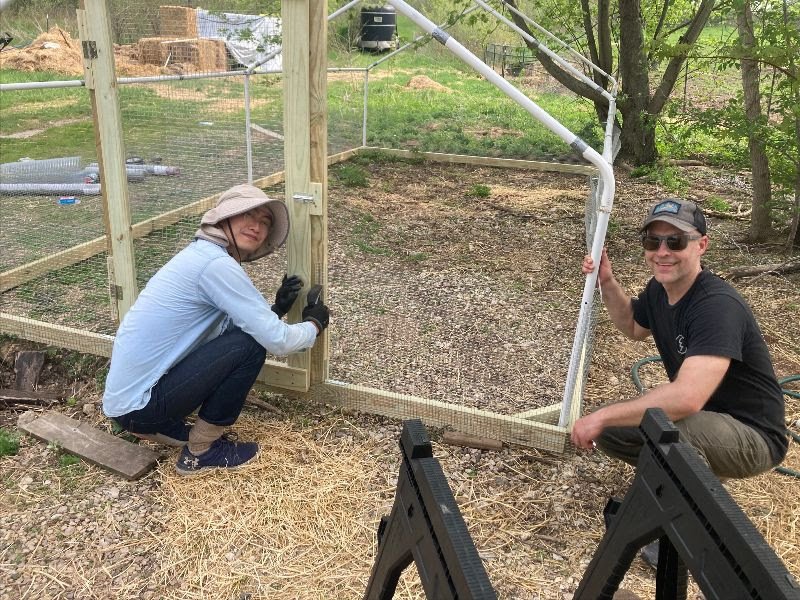FARM UPDATE
So many things happening on the farm! We had helpers for a farm work day. 190 chickens brought outside this past month and now we are back in stock with our chicken offerings (info in sales section at the bottom of the page). Sheep, pigs, chickens, are on the move with the grass growing - cattle start their rotation tomorrow! Also, a new monthly segment I'm excited to launch!
This month, we were so thrilled to have scholar-learner-volunteers at Root and Sky Farm. Members of an ethics seminar from Wheaton College invited Duke University scholar Norman Wirzba to help them work through questions and issues of creatureliness. They read a forthcoming book, The Agrarian Spirit, by Wirzba and then brought the scholar and themselves out to the farm to work out some of the ideas--literally! Members of the seminar built a portable chicken shelter, helped move fences in the fields for rotational grazing of the sheep, moved fences in the woods for the silvopastured pigs, and laid sheeting in the brand new baby permaculture orchard--all in a BLAZING heatwave.
They feasted with us on local foods--potatoes, green garlic, dried beans, yogurt, pea shoots, lettuce, kale, blueberries, and honey--many raised by our friends from Woodstock Farmers Market. And of course we had Root and Sky sausage, bacon, and beef--oh and our rhubarb and foraged raspberries too!
Photo 1 (by Christine Jeske) Chuck Liu and Jamie Huff working on a chicken shelter.
Photo 2 (by Nadine Rorem) Norman Wirzba, of the Kenan Ethics Institute at Duke University, resting after helping build a chicken shelter in 94 degree heat! He's eating a custard tart with foraged raspberries from Root and Sky (made special for him because of a line about custard and raspberries in his forthcoming book.
Photo 3 (by Kristen Page) Kat, a wonderful farm helper, hanging with Thomasina.
For those who are new to what we are doing at Root & Sky Farm, we rotate our livestock with electric netting or rope through our pasture and wooded areas. You can see the netting in opening pic. Every couple days or so, they are moved to a new area to munch on the greens that are in their paddock, and they give us some natural fertilizer as a trade. Rotational grazing is essential on the farm and I've written about it in the past, and will be sure to re-visit the topic in the future because of how important it is for the health of the land, the livestock, and the meat and eggs produced. Hard to stop there, but if this is a new concept and you want to learn more, you can send me an email and I can send some more information.
Sansa apple blossom. Our first blossom on the farm.
Monthly I'm going go over one plant on the farm, or a plant I want to incorporate into the farm. It could be an orchard fruit plant, a grass, perennial flower, etc.. Plenty of options, so here we go:
MONTHLY ROOT & SKY FARM PLANT
The livestock, pasture, and woods are the backbone of Root & Sky Farm. Adding to the diversity of our farm, in April of 2022 we started a 100 tree and 220 shrub permaculture orchard. I spent way too much time researching the plants for the orchard, so to help justify those hours that I refuse to count, I'm going to pick one plant a month and try to explain why that plant is on our farm, why I want add it soon, or maybe even why that selection was a mistake. This month's selection is....
Sansa Apple Tree - I chose to lead with this plant because it was lovely to see the first apple blossoms (which I have now removed so the tree can focus on growth rather than fruit production). Sansa was the result of a cross between Gala and Akane apple trees in 1969, and released in 1988.
Cummins Nursery notes about the Sansa Apple that encouraged me to purchase the apple tree "one of the best early apples, sweet and disease resistant...sweetness of Gala and acidity of Akane...suitable for organic orchard"
https://www.cumminsnursery.com/buy-trees/product-detail.php?type=tree&id=458
- Disease resistance is important because we do not want to spray chemicals.
- Early harvest around Sept 1st for a fairly complex apple. Should be the first apple picked. Nice to add an apple or two when pears, a plum or two, late peaches, aronia berries, and cherry bushes are also producing!
- Mostly for fresh eating and only stores for a month or two but that's okay! There will be plenty other apple varieties that are great for other uses and store much better. In early September, crunching into an apple off the tree sounds great!





